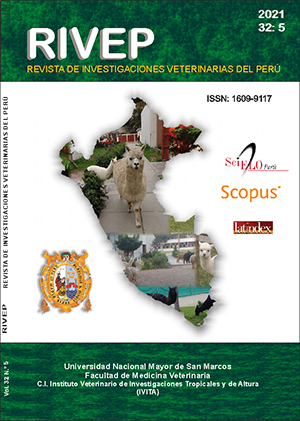Hematological reference parameters of indigenous guinea pigs (Cavia porcellus)
DOI:
https://doi.org/10.15381/rivep.v32i5.18417Keywords:
haemoglobin, haematocrit, red blood cell count, cellular responseAbstract
The present study aimed to determine the haematological parameters of indigenous guinea pigs in the Ayacucho area, Peru, taking into account age, sex and physiological status (pregnancy, lactating, weaned). Blood samples were taken and analysed manually following routine laboratory methods. The red blood cell count and haematocrit and haemoglobin values were higher in guinea pigs of the lactating stage compared to weaned animals, and in males as compared to females. Likewise, the red blood cell count and the haematocrit and haemoglobin values of pregnant females were like those of lactating guinea pigs. In the leukocyte formula, lymphocytes had the highest frequency, followed by neutrophils. The reference values reported in the different age groups and physiological status will allow better clinical decisions to be made.
Downloads
Downloads
Published
Issue
Section
License
Copyright (c) 2021 Katherine Patricia Oriundo Núñez, Pedro Mauricio Delgadillo Coronado, Renzo André Arévalo Pérez, Miriam Ibet Alfaro-Astorima, Sandra Bautista Gómez

This work is licensed under a Creative Commons Attribution 4.0 International License.
AUTHORS RETAIN THEIR RIGHTS:
a. Authors retain their trade mark rights and patent, and also on any process or procedure described in the article.
b. Authors retain their right to share, copy, distribute, perform and publicly communicate their article (eg, to place their article in an institutional repository or publish it in a book), with an acknowledgment of its initial publication in the Revista de Investigaciones Veterinarias del Perú (RIVEP).
c. Authors retain theirs right to make a subsequent publication of their work, to use the article or any part thereof (eg a compilation of his papers, lecture notes, thesis, or a book), always indicating the source of publication (the originator of the work, journal, volume, number and date).



